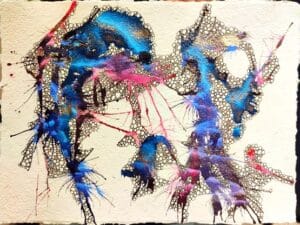Naming your artwork can be so difficult, especially if, like me, you paint abstract works.
Even for realistic artists, simply numbering your pieces (e.g., Sunset 1, Sunset 2) feels uninspired. So, how do you find the perfect title? Here are some approaches:
- Let the Art Speak to You
Some artists say the title comes to them naturally as they create. If that doesn’t happen for you, don’t worry! Try these options:
- Describe the scene (for landscapes): Add details like time of day, weather, or season (Winter Morning at the Lake).
- Focus on colour or design: Use hues (Crimson Tide) or rhythmic elements (Beat, Clash, Boom).

Colourful Coral
- Draw from Daily Life
If your work reflects your surroundings, incorporate those details:
- Breakfast in Bed
- The View from My Paris Window
- Channel Emotions or Themes
My abstract pieces often represent feelings, like the isolation of the Covid-19 pandemic or the circle of life. I search for emotional words (Solitude, Fragile Embrace) to match the mood.
- Borrow (and Credit) Inspiration
Pay homage to influences without copying:
- Sunflowers, After Van Gogh (assuming that your work is a still life of sunflowers, of course).
- Hide a Story
A teacher once advised me to include subtle secondary elements – a hidden figure or animal – to add mystery in my works. Titles can hint at these secrets (The Hidden Path, Whispers in the Field).

- Symbolism
Like Dali’s The Persistence of Memory, use symbols to deepen meaning. A simple object (a clock, a bird) can evoke bigger ideas.
Stay tuned for Part 2, where we’ll discuss why titles matter, avoiding pitfalls, and practical tips for naming your work!
NB I do not get paid to endorse any people or brands mentioned in my blogs.
If you enjoyed this post, please like, share and follow me. Sharing, liking and following raises the algorithms in my favour.
Thank you for your support.

